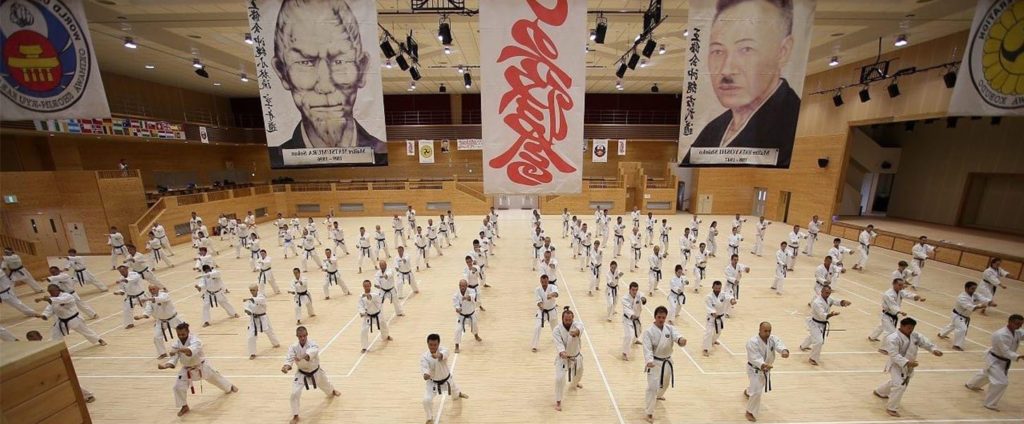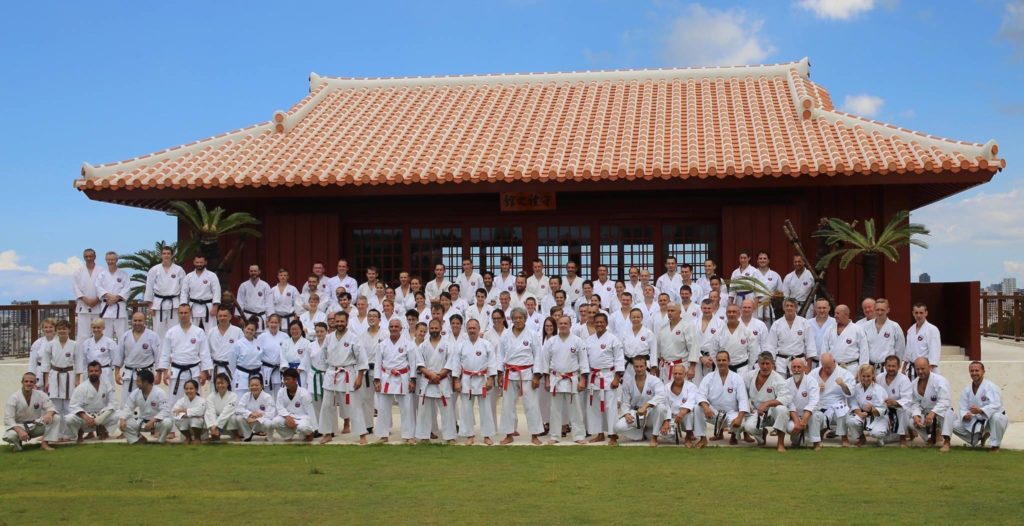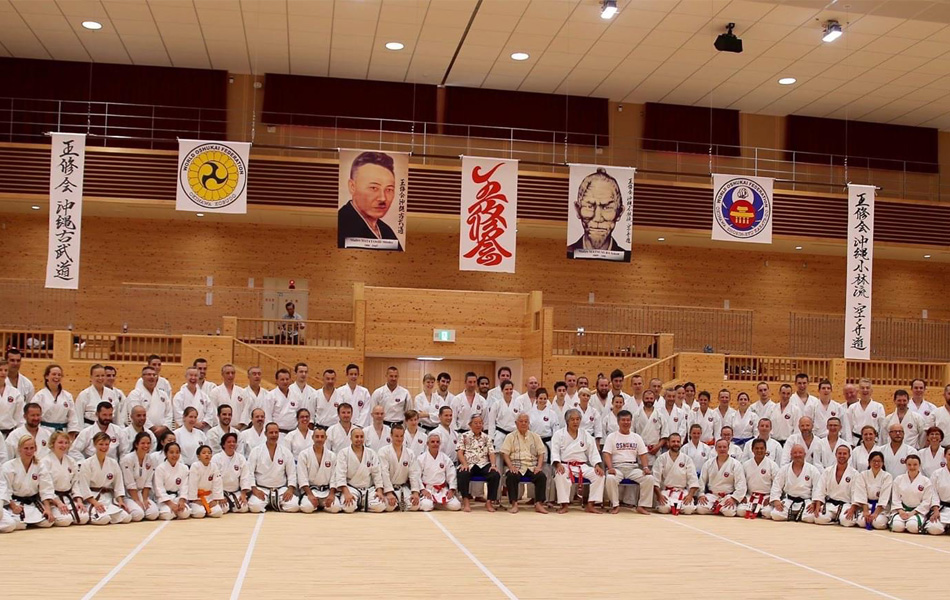About World Oshukai
The World Oshukai Foundation (WOF) was founded by Okinawan Grand Master Kenyū Chinen. Today, the WOF has dojos spread across the World, from North and South America, to Europe, Africa, and Asia, with a network of over 6,000 members. Our members strive for self-imporvement through the the traditional arts of Okinawan Shorin-ryu Karate and Okinawan Kobudo.
World Oshukai Federation Committee Administration
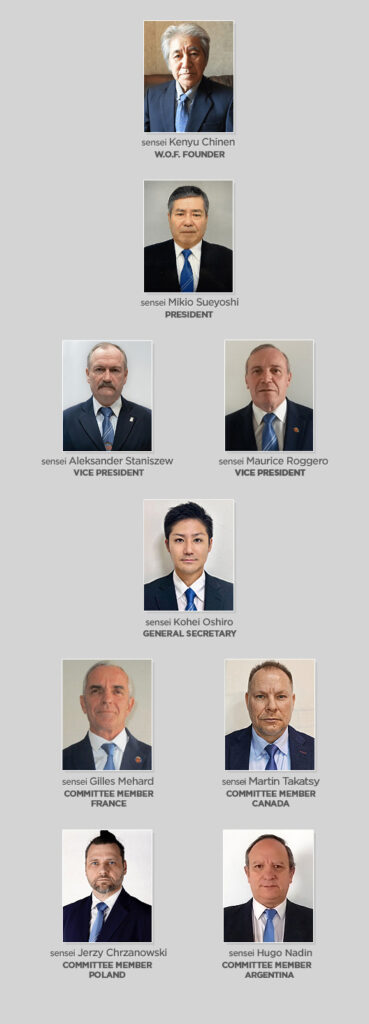
World Oshukai Federation Three Pilars of Discipline

Tanren – Discipline
Tanren is the conditioning of the mind and body through rigorous training. The Japanese for training lesson (稽古 – keiko) is made of two kanji, the first meaning ‘to consider’ and the second ‘old’; that is “knowing the old and knowing what should be done now”. It is with this in mind that we train both the mind and body. During training, the mind and body affect each other in turn. There always exists a balance between the two. Continued repetiton is important to refine both the body and mind, and so, with the goal to instill braviary and equanimity, we condition ourselves through the tanren.
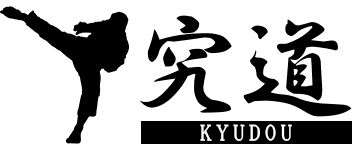
Kyūdō – Investigation
In traditional Okinawan karate and kobudo, both guarding and attacking are achieve through forward motion, and is symbolized through its forms. This attitude itself can be said to be the philosophy of traditional karate and kobudo. The spirit of fighting is not retreat but advancement, for this resolution is the path to success. Kyudo symbolises the drive to constantly seek advancement and improvement at all times. In other words, to think proactively about all things, not just traditional karate and kobudo, is to invite success.
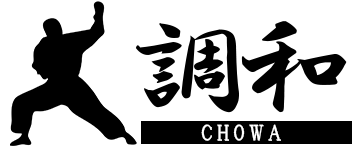
Chōwa – Harmony
I think humans are harmonious creatures. There is wonderful balance between up, down, left, and right. The forms of karate (kata) passed down through history are composed to reflect this harmonious structure along the axes of front-back, up-down, left-right. In traditional Okinawan karate, these forms are of importance. Harmony can be seen in the construction and performance of these forms. Observing our own lifestyle, we may say that everything is composed of harmonious and inharmonious elements. Through karate, one can learn to harmonize with themselves, other people, and their environment, and find stability through harmony of both the mind and body.
The Symbolism of WOF
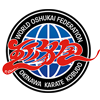
【The WOF Logo】
The logo of the World Oshukai Federation contains three kanji that spell out ‘Oshukai’.
The first is ‘King’ (王 – Ō): Shorin-Ryu is the school descending from Shuri-Te, which was practed at Shuri Castle; This kanji also symbolises virtue over conquest. The second kanji is ‘Improvement’ (修 – Shū): also containing the meaning of ‘self-discipline’, we aim to create strength of character. The last is ‘Meeting’ (会 – Kai): the gathering of people with the same aspirations.
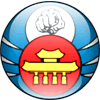
The Okinawa Shorin-Ryu Karate Emblem
In the centre, the gates to Shuri Castle, ‘Shuremon’, is a clear symbol of Okinawa and the path of Shuri-Te. The blue background symbolises the beautiful sea surrounding Okinawa.
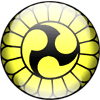
The Okinawa Kobudo Emblem
The surrounding 18 golden petals of a chrysanthemum symbolises well-being. In the centre of the golden background there is a black, three-armed tomoe that was the coat of arms of the Sho dynasty. The tomoe symbolises the unification of three kingdoms of Okinawa (the Northern Kingdom, the Middle Kingdom, and the Southern Kingdom).
The Okinawa Shorin-Ryu Karatedo
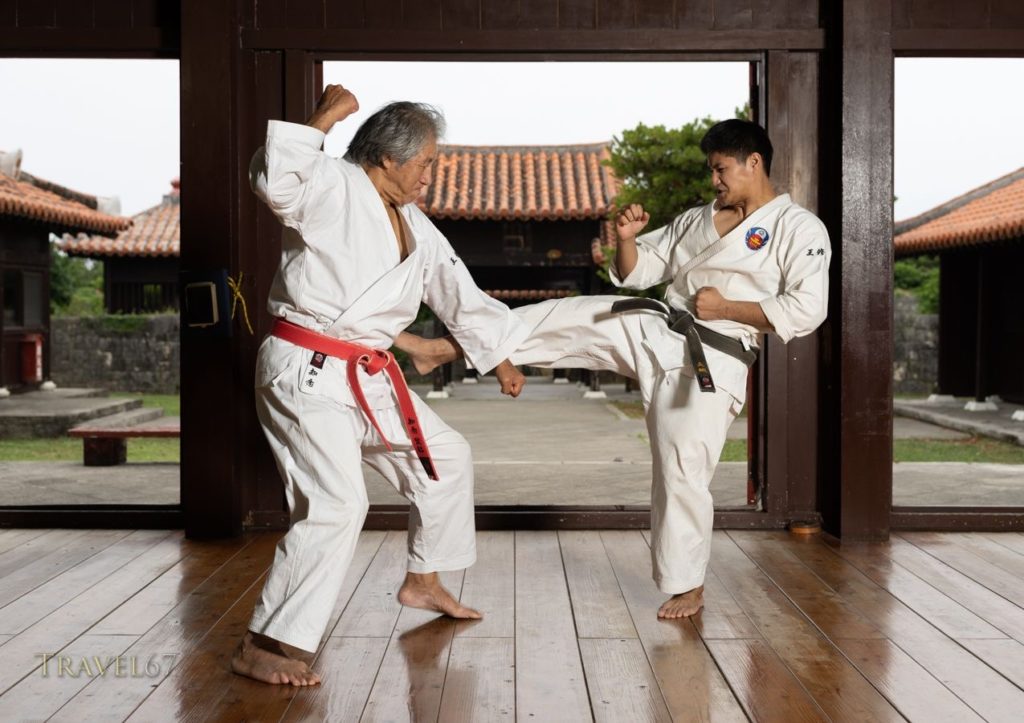
Karate is a martial art that originated in Okinawa. It is said to originate from the ancient Ryukyu martial art of ‘Tee’. Named Shuri-Te, this school of ‘Tee’ was mainly trained by the Shuri warrior class, including the royal family of the Ryukyu Kingdom. Modern Shorin-Ryu is descended from Shuri-Te.
Master Sōkun Matsumura (松村宗棍 1809-1899) was well known throughout Ryukyu as “Bushi Matsumura” and is deeply engraved in Ryukyu’s history. He served as the royal martial arts instructor and taught many deciples, including three generations of the late Shō Dynasty.
One of Master Matsumura’s famous disciples, Anko Itosu (糸洲安恒 1831-1915), was also called a master of Shurite. In 1901, Master Itosu introduced karate into the public school physical education for the first time, contributing to the popularisation of karate. Itosu also created the Pinan system as a traditional teaching method.
Master Itosu’s famous disciple, Master Chōshin Chibana (知花朝信 1885–1969), named his own line Shorin-Ryu in 1933 in order to preserve and develop upon the traditions handed down from the previous generations. In 1948, he established the Okinawa Shorin-ryu Karate Association.
Masters Shūgorō Nakazato (仲里周五郎 1920-2016) and Katsuya Miyahira (宮平勝哉 1918-2010) are direct disciples of Master Chibana and were successors to the Okinawa Shorin-Ryu school. Our Master Kenyū Chinen (知念賢祐 1944-) studied under both Masters Nakazato and Miyahira, and is successor to the Okinawa Shorin-Ryu school, which is a traditional branch of Shuri-te.
The foundational forms of Okinawan Shorin-Ryu is said to be Naihanchi, which contains the most fundamental conditioning. Alongside that, forms are also practiced from Pinan, Passai, Ku-Sanku, Chintō, and Gojjushiho.
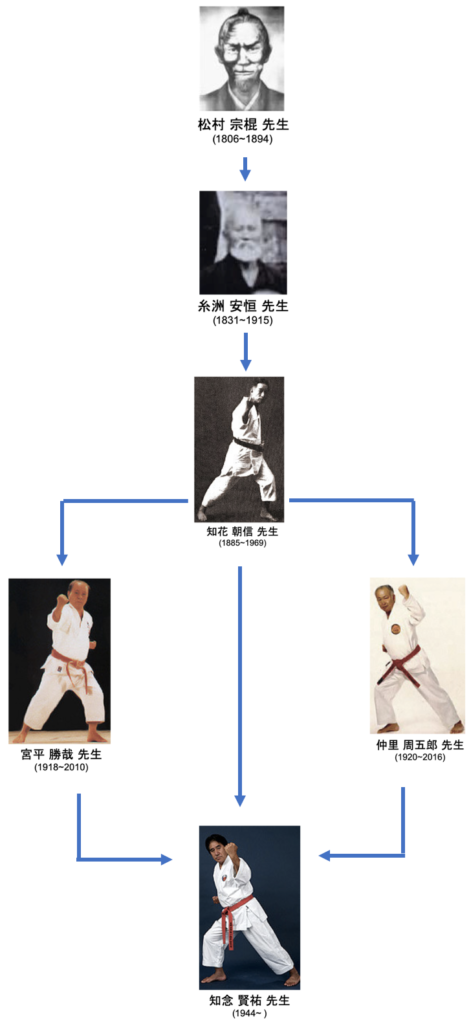

1969 – Master Nakazato’s Dojo (Master Chinen, sixth from the top-right)
The Okinawa Matayoshi Kobudo
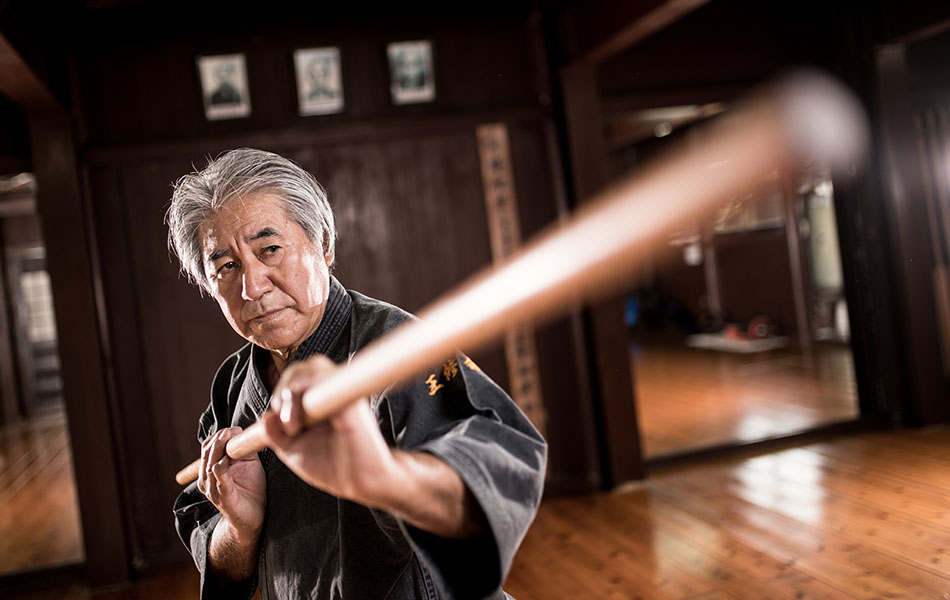
The word ‘Kobudo’ was used in Okinawa to generally describe the training of tools in martial arts. Practitioners trained in each weapons alongside karate practice. Since the time of the Ryukyu Kingdom, various weapons techniques were developed from the tools of daily life, and spread predominantly around Shuri and Naha.
The lineage of our style takes root in Matayoshi Kobudo, which was handed down mainly by the Matayoshi family. Matayoshi Kobudo was formalised by Master Shinchin Matayoshi (又吉眞珍) and later developed by Master Shinkō Matayoshi (又吉眞光 1888-1947). Shinkō Matayoshi’s son, Shinpō Matayoshi (又吉眞豊 1921-1997), was a leader of Kobudo martial arts in Okinawa and established the Okinawa Kobudo Federation in 1970. In 1972, the first Kobudo Competition was held, and with it rapid popularisation.
Matayoshi Kobudo is now being practiced not only in Okinawa but all over the world. Our Master Kenyū Chinen (知念賢祐 1944-) inherited direct tutelage from Master Shinpō Matayoshi as his deciple. The main weapons used in Okinawa Kobudo include Bō, Sai, Tonkwa (Tonfa), Nunchaku, Jō, Sansetsukon, Nunti, Ēku, Kama, Kuwa, Timbē, Suruchin, and Tekko.
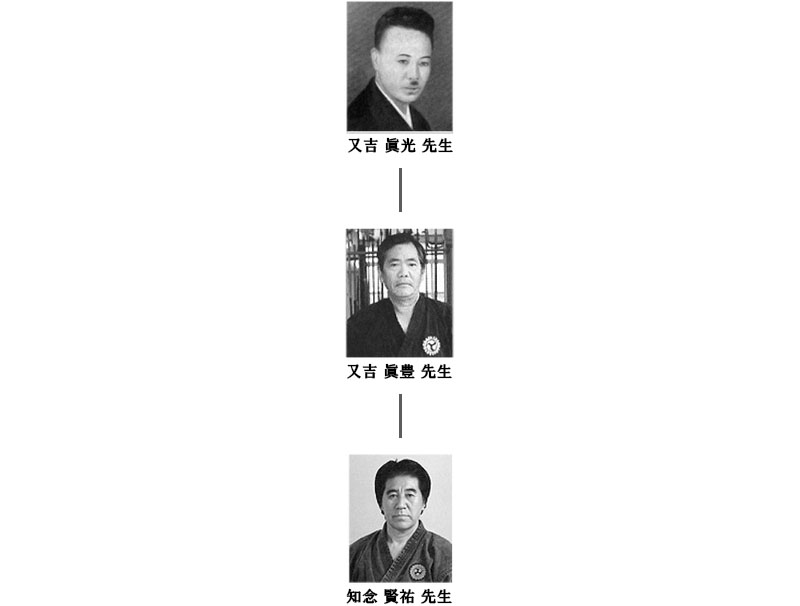
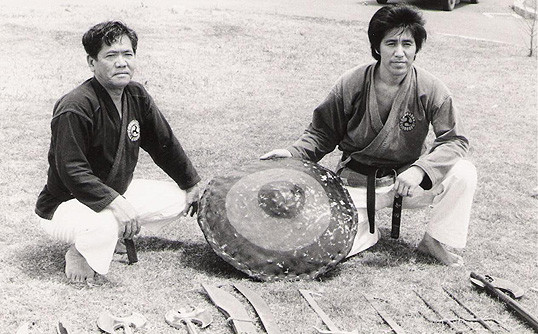
Masters Shinpo Matayoshi Sensei and Kenyū Chinen

